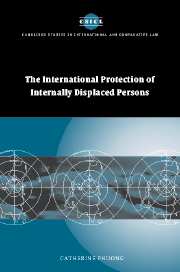Book contents
- Frontmatter
- Contents
- Acknowledgments
- Table of cases
- Table of treaties and other international documents
- List of abbreviations
- Introduction
- 1 Internally displaced persons and refugees: conceptual differences and similarities
- 2 The legal protection of internally displaced persons
- 3 The institutional framework of protection for the internally displaced
- 4 Protection strategies for the internally displaced
- 5 Case study: internal displacement in Bosnia and Herzegovina
- 6 Reconceiving sovereignty and intervention
- Conclusions
- Annex 1: The Guiding Principles on Internal Displacement
- Bibliography
- Index
- CAMBRIDGE STUDIES IN INTERNATIONAL AND COMPARATIVE LAW
3 - The institutional framework of protection for the internally displaced
Published online by Cambridge University Press: 17 July 2009
- Frontmatter
- Contents
- Acknowledgments
- Table of cases
- Table of treaties and other international documents
- List of abbreviations
- Introduction
- 1 Internally displaced persons and refugees: conceptual differences and similarities
- 2 The legal protection of internally displaced persons
- 3 The institutional framework of protection for the internally displaced
- 4 Protection strategies for the internally displaced
- 5 Case study: internal displacement in Bosnia and Herzegovina
- 6 Reconceiving sovereignty and intervention
- Conclusions
- Annex 1: The Guiding Principles on Internal Displacement
- Bibliography
- Index
- CAMBRIDGE STUDIES IN INTERNATIONAL AND COMPARATIVE LAW
Summary
The study of internal displacement cannot be separated from a study of mechanisms, and this chapter therefore evaluates how UN actors approach the IDP issue. It explores the implications of a human rights approach to the problem of internal displacement on the nature of the institutional response to that problem. Indeed, while the analysis concentrates on humanitarian actors, internally displaced persons are victims of human rights violations. Examining UN actors' policies on internal displacement should therefore reflect how these actors are integrating human rights concerns within their respective mandates.
Although a multitude of actors are involved with internally displaced persons, this chapter deals mainly with agencies within the UN system, with the exception of International Committee of the Red Cross (ICRC), the International Organization for Migration (IOM) and the World Health Organization (WHO). Most agencies have been involved with internally displaced persons for more than ten years, but it is only recently that they have explicitly asserted an IDP role and attempted to formulate a specific policy response to the problem of internal displacement. The first two sections below concentrate on UNHCR, while the third section reviews the roles of other agencies. With so many actors having a mandate covering IDP issues, issues of inter-agency cooperation are crucial to ensure that their needs are fully covered: the fourth section below reviews existing coordination mechanisms with regard to internally displaced persons and recent initiatives to improve such mechanisms and ensure that human rights issues are adequately addressed.
- Type
- Chapter
- Information
- The International Protection of Internally Displaced Persons , pp. 76 - 116Publisher: Cambridge University PressPrint publication year: 2005

